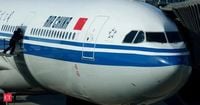On the morning of October 19, 2025, what began as a routine Air China flight from Hangzhou to South Korea’s Incheon International Airport quickly turned into a harrowing ordeal for the 160 passengers and crew on board. Just as the aircraft soared above the clouds, a sudden crackle and a loud explosion shattered the calm. Flames and dense smoke billowed from an overhead compartment, sending panic through the cabin and forcing the crew into swift action.
According to France 24, the culprit was a lithium battery that had spontaneously ignited in a passenger’s carry-on luggage stored in the overhead bin. "A lithium battery spontaneously ignited in a passenger's carry-on luggage stored in the overhead bin on flight CA139," Air China confirmed in a statement on Weibo. The flight, which had departed Hangzhou Xiaoshan International Airport at 9:47 am local time, was en route to Seoul when the emergency unfolded.
Passenger-captured video, shared widely on Chinese social media and on X, depicted the chaos: bright flames licking at the compartment’s lining, thick smoke curling into the aisles, and concerned travelers alerting flight attendants. One passenger, quoted by local media and reported by New York Post, described hearing a loud explosion moments before the fire erupted. Another traveler was heard shouting “hurry up!” in Korean as the smoke thickened, underscoring the urgency of the moment.
The quick-thinking crew leaped into action. Two flight attendants dashed down the aisle wielding fire extinguishers, while others urged passengers to remain seated and calm. Within moments, they managed to contain the blaze, following established emergency protocols. Air China later stated, "The crew immediately handled the situation according to procedures, and no one was injured." The airline’s professionalism in the face of danger likely prevented a much more serious outcome.
Still, the danger was not over. As smoke continued to fill the cabin, the pilots made the decision to divert the plane to Shanghai Pudong International Airport to ensure the safety of everyone on board. Flight-tracking site Flightradar24 showed the aircraft landed safely around 11 am. Emergency responders were ready and waiting on the tarmac, but fortunately, there were no injuries reported. Photos shared online revealed scorched lining above several rows of seats—a stark reminder of how close the incident came to disaster.
After a replacement jet was arranged, the shaken passengers resumed their journey to Seoul. Yet, the scare left a lasting impression—not just on those who experienced it firsthand, but also across the global aviation community. The incident quickly reignited a familiar and urgent debate: just how safe are lithium batteries in flight?
Lithium batteries, found in everything from smartphones and laptops to smartwatches, fitness trackers, and especially portable power banks, have become indispensable for modern travelers. But as the Federal Aviation Administration and the Transportation Security Administration have long warned, they can also pose significant risks if damaged, overcharged, or packed improperly. Airlines generally restrict passengers from carrying lithium batteries in checked luggage, and all uninstalled lithium batteries—such as external power banks—are strictly prohibited from checked baggage.
According to Khaleej Times, the Air China incident is just the latest in a series of lithium-battery-related events involving Asian carriers in 2025, highlighting a growing trend that has safety experts on edge. The danger lies in the batteries’ chemistry. Power banks, in particular, rely on lithium-ion or lithium-polymer cells, which can overheat if overcharged or damaged. This can lead to a phenomenon called thermal runaway, where the battery’s temperature rapidly escalates, potentially causing fires or explosions. Experts have warned that thermal runaway can produce open flames reaching over 1,000°C—an alarming prospect in the confined quarters of an aircraft cabin.
“Lithium-powered devices are safe when handled properly, but they can pose a risk if damaged or packed incorrectly,” explained Nick Careen, IATA’s Senior Vice President for Operations, Safety and Security, just days before the Air China scare. In fact, the International Air Transport Association (IATA) had launched a global campaign, ‘Travel Smart with Lithium Batteries’, to promote the safe handling of rechargeable battery devices. The timing could not have been more prescient.
IATA’s passenger survey revealed that 83 percent of travelers carry a phone, 60 percent a laptop, and 44 percent a power bank. While most travelers believe they understand the rules, the survey found that half wrongly think it’s acceptable to pack small lithium-powered devices in checked luggage, and nearly as many believe power banks can go in checked bags. This widespread misunderstanding only increases the risk of mid-air incidents.
Beyond the usual suspects—phones and laptops—lithium batteries are now found in a dizzying array of personal and travel items: tablets, e-readers, wireless headphones, cameras, portable speakers, handheld gaming consoles, electronic styluses, electric toothbrushes, shavers, hair-straighteners, e-cigarettes, handheld fans, torches, medical devices like hearing aids and glucose monitors, and even compact tools or gadgets like screwdrivers and laser pointers. The proliferation of these devices makes vigilance all the more important.
Some airlines are already tightening the reins. As reported by Khaleej Times, UAE carriers Emirates, flydubai, and Etihad Airways have imposed stricter rules on power bank use since October 1, 2025. Each customer is allowed only one power bank, which must be carried in hand baggage (never checked), switched off, and protected from short-circuit and unintentional activation. Devices over 100 watt-hours are strictly prohibited, and the watt-hour rating must be clearly labeled. Power banks cannot be placed in overhead compartments but must be stored in the seat pocket or under the seat in front—ensuring quick access and compliance with safety procedures.
For travelers, these rules may seem onerous, but the Air China incident underscores their necessity. IATA offers seven straightforward tips: pack only the devices and batteries you need, stay alert for hot or damaged devices, always carry battery-powered items in hand baggage, protect loose batteries, remove all lithium batteries from bags checked at the gate, check the size of your batteries, and always confirm your airline’s specific policies. These guidelines are more than bureaucratic red tape—they’re a vital line of defense against in-flight emergencies.
While the passengers and crew of Air China flight CA139 escaped unharmed, the incident serves as a sobering reminder of the hidden hazards that can accompany even the most familiar gadgets. In an era where travel and technology are increasingly intertwined, a little extra caution can mean the difference between a safe journey and a terrifying ordeal.
For the aviation industry, the message is clear: as lithium batteries become ever more ubiquitous, the need for vigilance, education, and robust safety protocols has never been greater. The sky may be the limit, but safety must always come first.






